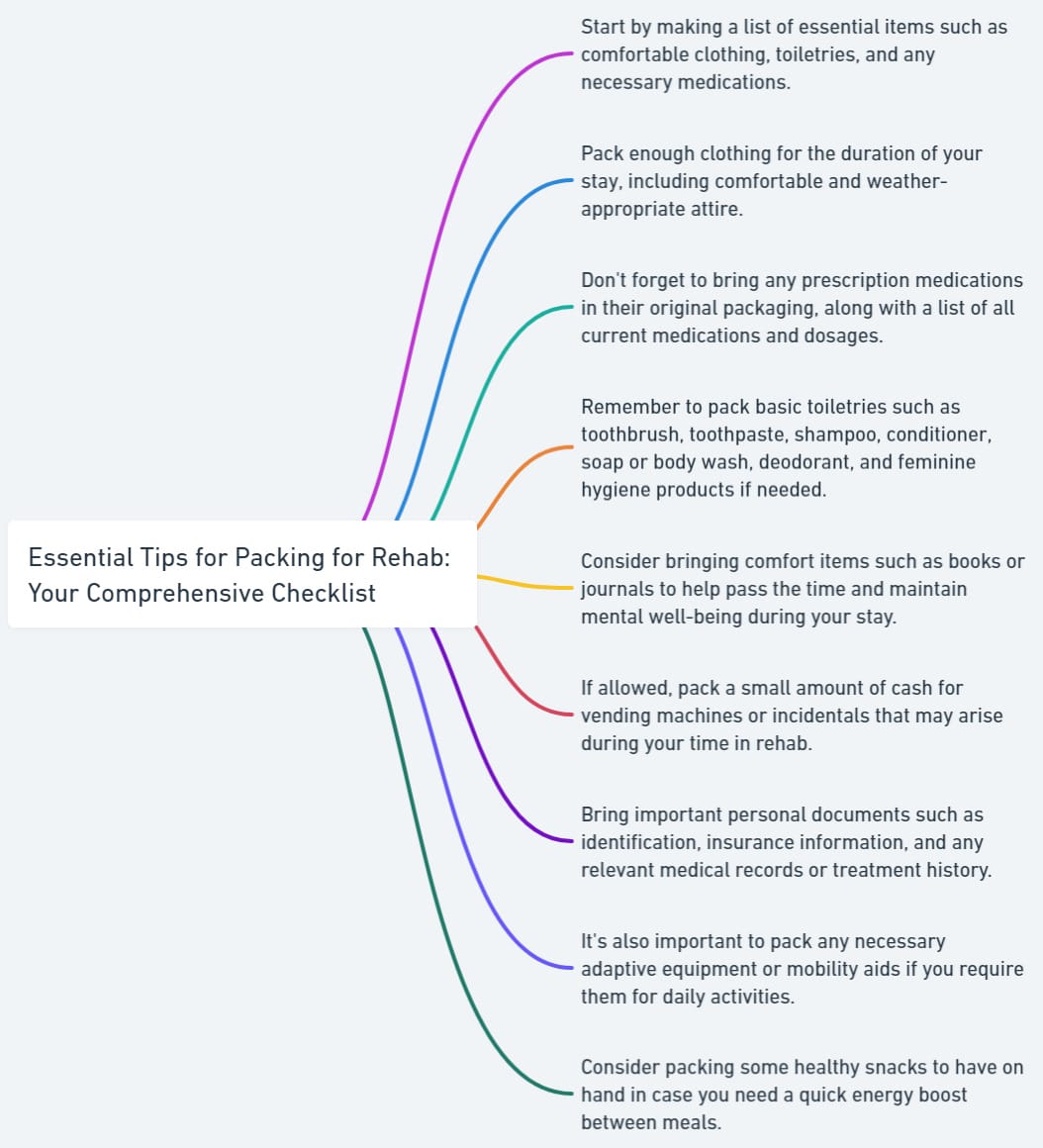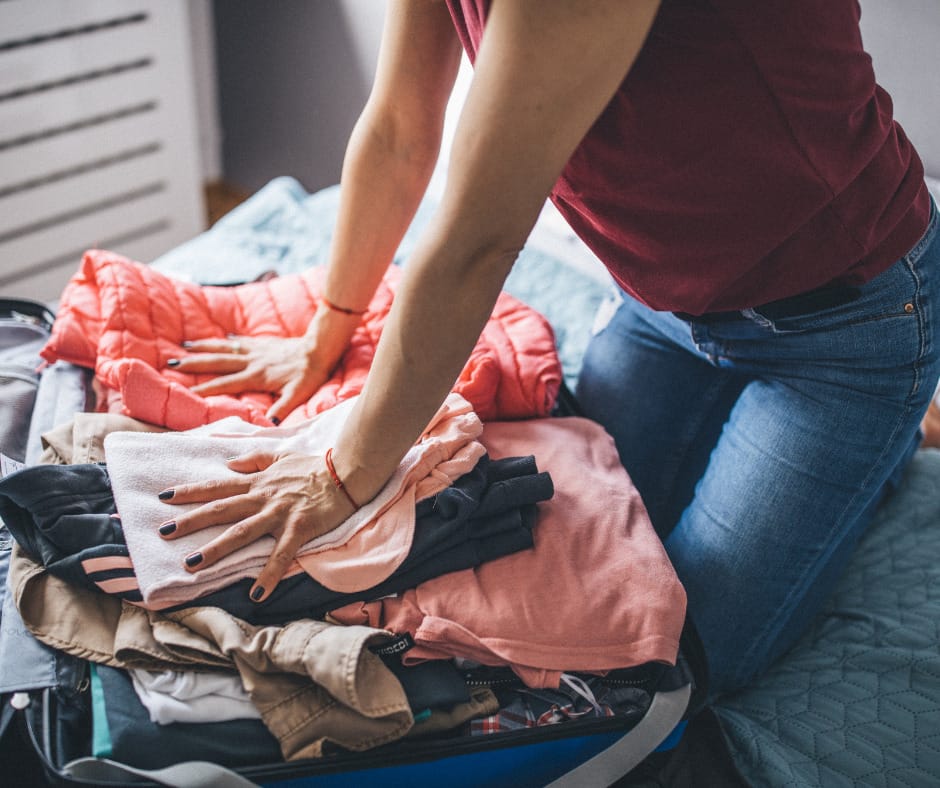Entering rehab is an essential step towards recovery and a healthier lifestyle. However, the journey can be overwhelming, and being prepared is crucial to ensure a smooth and comfortable experience. To alleviate some of the stress and uncertainty that comes with packing for rehab, we have compiled a comprehensive checklist that covers everything you need to know. By following these guidelines and recommendations, you’ll be well-equipped to make the most of your time in rehab and focus on your recovery.
Key Takeaways
- Pack comfortable and practical clothing essentials according to the facility’s dress code.
- Include personal hygiene items, valid identification, financial items and electronics that follow guidelines on substance abuse content.
- Bring keepsakes and comfort items, prescription medications with refills as well as appropriate attire for events or activities.
Essentials for Your Rehab Stay: What to Pack
Starting your journey towards sobriety is a transformative decision, and the appropriate addiction treatment can significantly enhance the process. Preparing for your stay at an inpatient rehab facility involves more than just mental readiness; you’ll also need to pack the appropriate personal items. Having the essentials on hand can significantly enhance your inpatient treatment experience and contribute to a more successful recovery.
Here are the essentials for your impending rehab journey.
Clothing Essentials
When packing for a rehab center, comfort should be your top priority. After checking in to rehab, you’ll be undergoing intensive treatment, and the last thing you need is to feel physically uncomfortable. Here are some tips for what to pack:
- Avoid bringing expensive or revealing clothing, and instead, opt for garments that are easy to clean and suited to the climate.
- A week’s worth of basic clothing items should suffice, but don’t forget to double-check the rehab facility’s dress code.
- Consider any special occasions that may require a more formal outfit.
Beyond daily wear, you should pack comfortable shoes suitable for physical activities, shower-friendly flip flops, and long sleeve shirts to protect against the sun. If swimming is part of your rehab experience, make sure to pack a bathing suit (preferably a one-piece for women). And don’t forget to inquire about laundry facilities, as you may need to bring your own detergent, coins, or a debit card for payment.

Personal Hygiene Must-Haves
Keeping up with personal hygiene during your rehab stay is not only beneficial for your well-being but also contributes positively to your overall recovery process. Pack sealed and unopened toiletries, sufficient for 30 days, that do not contain alcohol. This includes items like toothpaste, shampoo, and shaving cream. When it comes to razors, opt for disposable or electric versions, as sharp objects may be prohibited in some rehab centers.
Remember, rehab facilities often have specific restrictions on personal hygiene items. For example, nail polish remover containing alcohol may not be allowed. Hence, it’s important to review the facility’s guidelines carefully and pack your items accordingly. Also, don’t forget to bring essential feminine hygiene products if needed, and an extra pair of eyeglasses along with a copy of the prescription.
Important Documents and Financial Items
Your rehab stay will likely involve several administrative processes, and having the necessary documents on hand can save you time and stress. Here are the documents you should bring:
- A valid form of identification, such as a driver’s license
- Documents of insurance coverage for drug rehab
- A limited amount of cash
- A credit or debit card may also come in handy for any additional expenses during your stay.
Regarding electronics, please note that rehab centers may have distinct policies about their use. Before bringing devices like cellphones or laptops, ensure they don’t contain any content related to drug abuse and confirm the facility’s guidelines on electronic usage.
Navigating Prohibited Items in Rehab Centers

Understanding what not to bring to rehab is just as important as knowing what to pack. Prohibited items can create complications during the admission process and may even hinder your recovery. Commonly disallowed items in rehab centers include illicit drugs, drug paraphernalia, and substances that could trigger relapse.
To avoid any issues, contact your treatment center in advance to obtain a list of prohibited items. This way, you’ll be prepared and avoid any surprises upon arrival. Keep in mind, every rehab center may have unique rules, so it’s important to reexamine and adhere to their specific guidelines.
Special Considerations for Personal Items
While packing the essential items is necessary, you might also want to think about including some personal items that could enhance your rehab experience and provide emotional support. These items can provide a sense of comfort, promote relaxation, and keep you engaged during your stay. Let’s explore some special considerations for personal items, including entertainment options and keepsakes.
Entertainment and Connectivity

During your stay at a rehab center, you’ll likely have some downtime between therapy sessions and activities. Bringing entertainment items can help you stay engaged and make your stay more enjoyable. Some recommended items to bring include:
- Reading materials, such as books or magazines
- Music players or electronic devices (check with the rehab center for their specific policies)
- Art supplies for creative activities
- Puzzle books or games to keep your mind active
It’s important to note that while reading materials are generally permissible and encouraged, some rehab centers may have restrictions on electronic devices or content related to substance abuse. Always check with the rehab center for their specific guidelines and policies.
Before including your gadgets, consult your rehab facility to understand their rules about the use of electronic devices. Proper communication can help you avoid any potential issues and ensure a smooth rehab experience.
Keepsakes and Comfort Items

Personal keepsakes can provide emotional support during your rehab stay by reminding you of your family members and the support you have. Items like photo albums, scrapbooks, or recovery-themed jewelry can serve as powerful reminders of the love and encouragement you have from friends and family.
Additionally, consider packing comfort items such as soft sweatshirts, new pajamas, or plush socks to provide physical comfort and a sense of familiarity during your stay. Hobbies and creative outlets, like knitting supplies or a journal, can also help you find positive ways to express yourself and manage your emotions throughout your rehab journey.
Medication Management During Your Stay
Managing medications is a significant part of your rehab experience. If you’re on prescription medications, it’s essential to bring them in their original containers, clearly labeled with dosage instructions. The rehab center will usually store and administer these medications as needed. Make sure you have a new 30-day supply and refills for all your medications.
It’s also beneficial to be informed about any limitations on over-the-counter medications. To avoid any complications, consult with your rehab facility about their guidelines for managing such medications during your stay.
Preparing for Special Events and Activities

Rehab centers like Lantana drug rehab often hold special events and activities to facilitate recovery and provide therapeutic experiences. To prepare for these occasions, pack appropriate attire and equipment, such as swimwear for pool-based activities or workout clothes for physical exercise sessions.
Besides clothing, you might need to bring certain equipment for activities such as yoga or art therapy. Consult with your rehab center to learn about any special events or activities planned during your stay, so you can pack accordingly and make the most of your rehab experience.
Additional Services and Amenities
Rehab centers typically offer a range of additional services and amenities to support your recovery journey. These may include yoga, art therapy, massage therapy, or even chiropractic treatments. Moreover, rehab facilities usually provide comfortable accommodations, nutritious meals, 24/7 medical supervision, therapy sessions, recreational activities, fitness facilities, and access to support groups.
Before your stay, it’s beneficial to ask about the specific services and amenities provided by your selected rehab center. This way, you can be better prepared and take full advantage of all the resources at your disposal.
Making the Most of Your Rehab Experience

Your attitude and mindset significantly influence the success of your rehab experience. By following the packing guidelines provided in this post, communicating with the facility staff, and maintaining a positive attitude, you’ll be better equipped to focus on your recovery and make the most of your time in rehab.
Remember, overcoming addiction is a challenging journey, but with the right preparation and mindset, you can emerge stronger and healthier. As you start your journey towards recovery, remember these packing tips and recommendations to help ensure a successful and satisfying rehab experience.
Summary
In conclusion, proper preparation for your rehab stay is critical to ensure a comfortable and successful experience. By carefully packing the essentials, adhering to facility guidelines, and bringing personal items for emotional support, you can focus on your recovery and make the most of your time in rehab.
As you prepare for this transformative journey, remember that overcoming addiction requires determination, support, and the right mindset. By following these packing tips and recommendations, you’ll be well-equipped to face the challenges ahead and emerge stronger and healthier than ever before.
Frequently Asked Questions
What do you wear to rehab?
For rehab, dress comfortably and casually in non-revealing clothing such as sweatpants, T-shirts, shorts, jackets, hats and athletic footwear. Avoid bringing clothing that could be a potential trigger. Additionally, bring a bathrobe and comfortable pajamas.
What should I pack in terms of clothing for rehab?
Pack comfortable, weather-appropriate clothing that follows the rehab center’s dress code, including enough for 7-10 days and any workout or swimwear needed.
Are electronic devices allowed in rehab centers?
Electronic device policies may differ between rehab centers, so it’s important to ask your chosen facility about their specific regulations before committing to a stay.
How should I manage my prescription medications during rehab?
Bring your prescription medications in their original containers with dosage instructions clearly labeled. The rehab center will store and administer them as needed. Be sure to follow the instructions given by your medical provider.
Can I bring personal keepsakes for emotional support during my rehab stay?
Yes, you can bring personal keepsakes to provide emotional support during your rehab stay. Photo albums, scrapbooks and recovery-themed jewelry can serve as reminders of the love and encouragement from friends and family.



